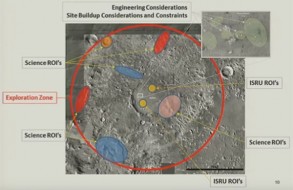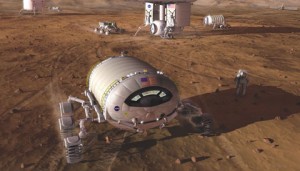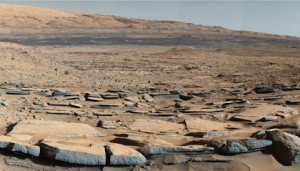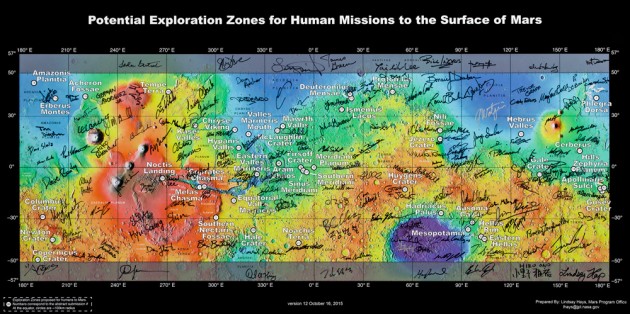Scientists and engineers gathered together to figure out what would make a good Martian landing site and what hurdles they’ll have to overcome for a 2035 launch so as to place humans on Mars.

Pack the toothpaste, kids, we’re going to Mars.
. . . and the mining equipment, the spacesuits, and the fertilizer, not to mention the two decades of research and development it’ll take to put humans on Mars.
But NASA and a whole lot of other dreamers (who have labs and PhDs to back them up) are determined that, as Yoda would put it, get there we will.
First Steps to Putting Humans on Mars
To start the ball rolling, dozens of scientists and engineers met this fall to hash out what they’ll need in order to successfully place humans on Mars. This endeavor isn’t like the rover missions, where we pick an interesting site, plop down a robot, and roll from one curiosity to the next. Instead, workshop attendees were evaluating what NASA organizers called the exploration zone concept — in essence, a field station.

NASA
As presented at the workshop, here’s a rough cut of what a crewed mission to the Martian surface would look like: a four-person crew would set up shop in an exploration zone roughly 100 km (60 miles) in radius. In that zone would be various things of scientific interest. The astronauts would also have a habitat, resource mining equipment, and a couple of pressurized rovers, able to go on adventures lasting maybe 10 to 15 sols (Martian days). Due to how the orbital mechanics work out, the crew would spend 300 to 500 days on the planet. Between two and five crews — and, due to the investment involved, probably the higher end of that range — would, one after the other, use the same exploration zone as home base, building up its infrastructure over time.
Some asked, why a single landing site for landing humans on Mars? Why not drop each crew somewhere new? The problem is, it takes a whole lot of resources to support a crew. They’re going to have to produce their own air, food, and fuel. Air, because Mars’s thin atmosphere is 96% carbon dioxide. Food, because packaged food loses its nutritional value after a couple of years, and we don’t want pioneers depending on a nutritionless stockpile. Fuel, because two-thirds of the mass of a four-person vehicle launching from the Red Planet’s surface will be propellant. Mission planners would rather not have to bring all that mass from Earth. Instead, the goal is to manufacture the propellant needed for all five crews’ departures right on site.
To give you a sense of the scale that’s going to be involved, Marianne Bobskill (NASA Langley Research Center) and her colleagues have put together an animation of what an exploration zone would look like after a few crews.
As you can see, it’s a major undertaking. But investing in one location will give humans a foothold in the most unforgiving landscape we’ve ever explored. The model NASA planners are following is the successful, albeit slow, buildup of human presence in Antarctica: a half century passed between the first expedition hut and McMurdo Station, but since then McMurdo has been a hub of scientific research on the frozen continent. NASA doesn’t just want to go to Mars, plant a flag, and go home. It wants to go and stay there after landing humans on Mars.
Water on Mars

NASA / John Frassanito & Associates
This level of commitment means that we have to think hard about resources, the feasibility of mining and using them, and finding (and plugging) the holes in our knowledge. The No. 1 requirement for an exploration zone is water. That might sound silly, given we’re talking about a desiccated planet. But we do know that water exists there, trapped in minerals and subsurface ice. We just don’t know exactly how much there is or how to harvest it.
Water will be crucial for astronauts, and not merely for drinking and watering plants. Water serves as a spacesuit coolant and for radiation protection, and — perhaps most importantly — it’s the base ingredient crews will need for manufacturing the propellant to fuel their departures. It’ll take roughly 20,000 kg of water to launch from the Red Planet’s surface, and that’s just for one, four-person crew. If we’re going to send five crews to the same site, we’ll need something like 100 metric tons of water.
That’s a lot of water.
At the moment, we don’t know how deep the deposits of sheet ice and hydrated minerals go; previous missions didn’t have the ability to find out. To answer this question, we’ll need the right kind of radar on an orbiter, and maybe additional groundwork, too, says Richard Davis, assistant director for science and exploration in NASA’s Science Mission Directorate. Plus, the workhorse surface imager, NASA’s Mars Reconnaissance Orbiter, is a decade old and starting to show its age. We need to replace it.
The Dirty Details of Exploration

NASA / JPL-Caltech / MSSS
Other issues also became clear during the workshop. For starters, we might need to land humans on Mars near the planet’s equator. High-latitude sites experience larger seasonal temperature variations, and it takes a lot of energy to keep equipment (not to mention people) warm when temperatures plummet on the Red Planet.
Then there are the realities of mining. How much water and metals are we really going to be able to harvest, and will they be worth the energy and effort it takes to obtain them? Robin Fergason (USGS) and others pointed out that we don’t even agree on how big a dust grain is. That sounds esoteric, but if we don’t know whether we’re trying to separate an 80-micron particle or a 5-micron particle from ore, can we design the right equipment for the job? The hard truths of “resource acquisition” will potentially be the focus of the next workshop in a couple of years.
The work left to be done is, frankly, daunting. And there’s no time to lose. From gathering more surface images for vetting sites to devising long-lasting hardware, scientists and engineers are going to be busy. Plus, they’re going to need to make sure they’re not talking past each other, because a mission “essential” to a scientist might be a mission “impossible” for an engineer.
But there is hope. “Human Mars missions have always been 20 years in the future,” Steve Hoffman (NASA Johnson Space Center) said at the workshop. “But this group is here now talking about, in all seriousness, where we’re going to send people. That has not happened before.”
Below, you'll find a map of all the potential exploration zones discussed at the workshop (the signatures are from the attendees) — but remember, this conference wasn't about picking a site so much as hashing out why various sites would be good or bad. You can also watch recordings from all the workshop presentations on the Lunar and Planetary Institute's YouTube channel.

This blog was updated on 28 December 2015 to include the simulated EZ video.
Explore the Red Planet yourself with our Mars globes.
 5
5









Comments
Robert-Casey
December 21, 2015 at 5:15 pm
We'd need to be sure that Mars has no life before people go there. Otherwise we would be confused by Earth life contamination. And if there is life on Mars, Earth life might wipe it out.
You must be logged in to post a comment.
Anthony Barreiro
December 22, 2015 at 12:18 am
I still think we should just keep sending robots. They live on solar or nuclear energy, they don't need water or air, and they don't need a round trip ticket. Every dollar we spend planning an improbable human mission 20 years from now is a dollar that won't be available for a robotic mission of certain feasibility in the next few years.
You must be logged in to post a comment.
mxyzptlk
December 26, 2015 at 9:12 pm
Anthony Barreiro, I've always agreed with your position about the folly of human visitation of DEAD, INHOSPITABLE MARS.
Even the low-Earth ISS has more going for it scientifically than a colossally expensive boondoggle Mars junket. I just can't understand the allure the Red Wasteland has for Earthlings. They should go take a vacation to the Gobi Desert and get this Mars thing out of their systems !
You must be logged in to post a comment.
December 27, 2015 at 9:10 pm
Concur wholly with Messrs Barreiro and Kopetz. Patrick Moore once wrote that it was a good thing that the Apollo landings ended when they did, because inevitably the return rocket would one day fail. Man had accomplished all he needed in that dismal place. The same for the even more remote and equally dismal planet Mars.
You must be logged in to post a comment.
Darian-Rachal
December 28, 2015 at 2:15 pm
I don't know Eric, I still think it would be pretty exciting to see men walking around on the moon again. I suspect that the next lunar explorers will not be from the US, however. I will have to say that every time I look at the photos from the surface of Mars, it's almost as if someone was standing there taking a photo. They never cease to amaze me.
You must be logged in to post a comment.
You must be logged in to post a comment.